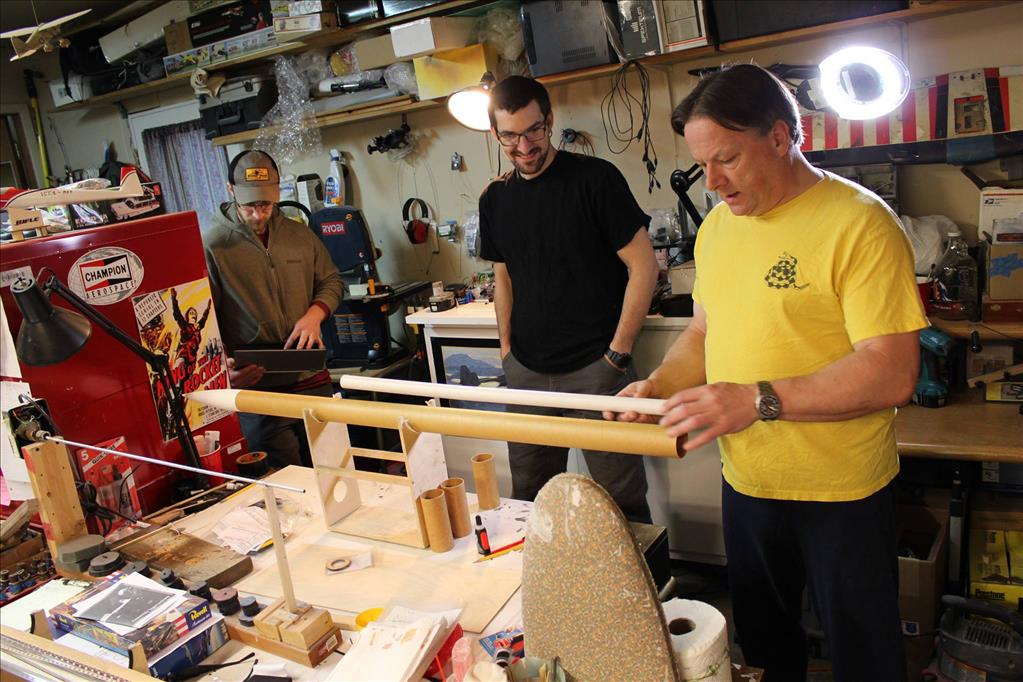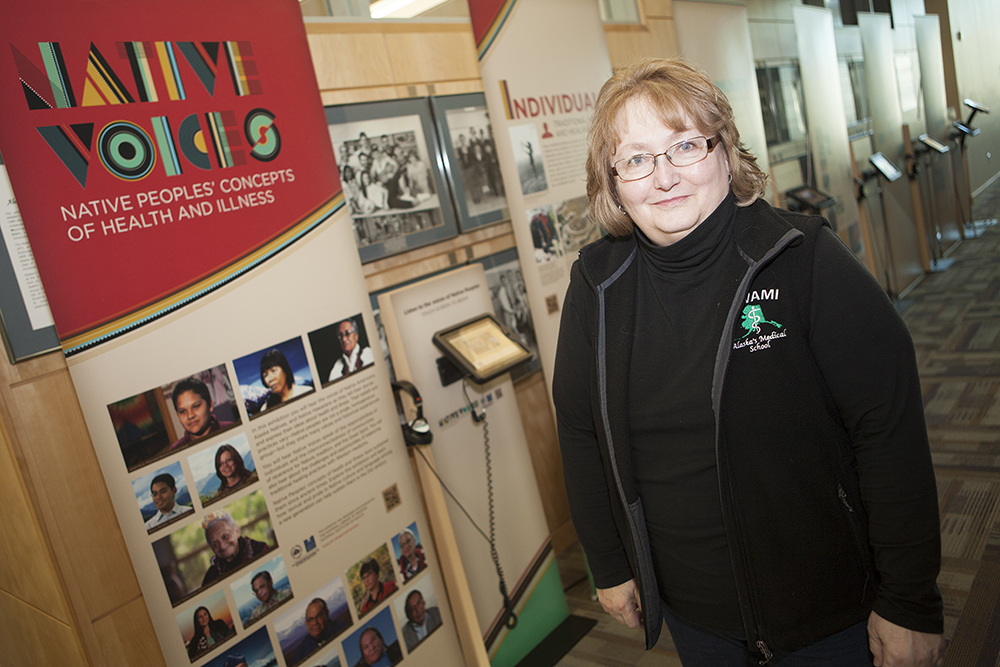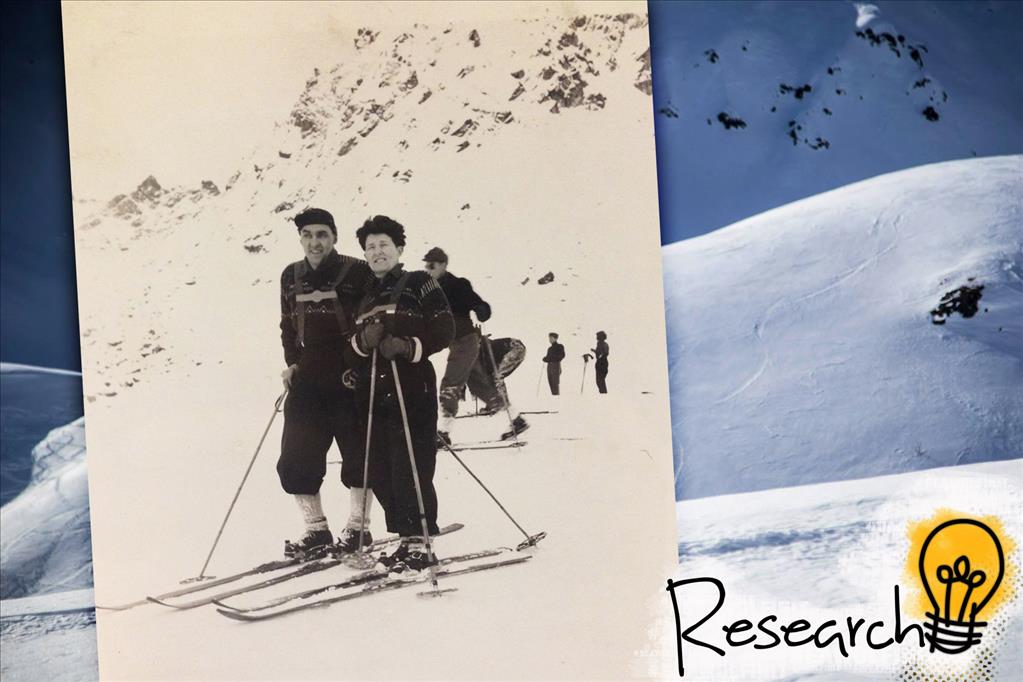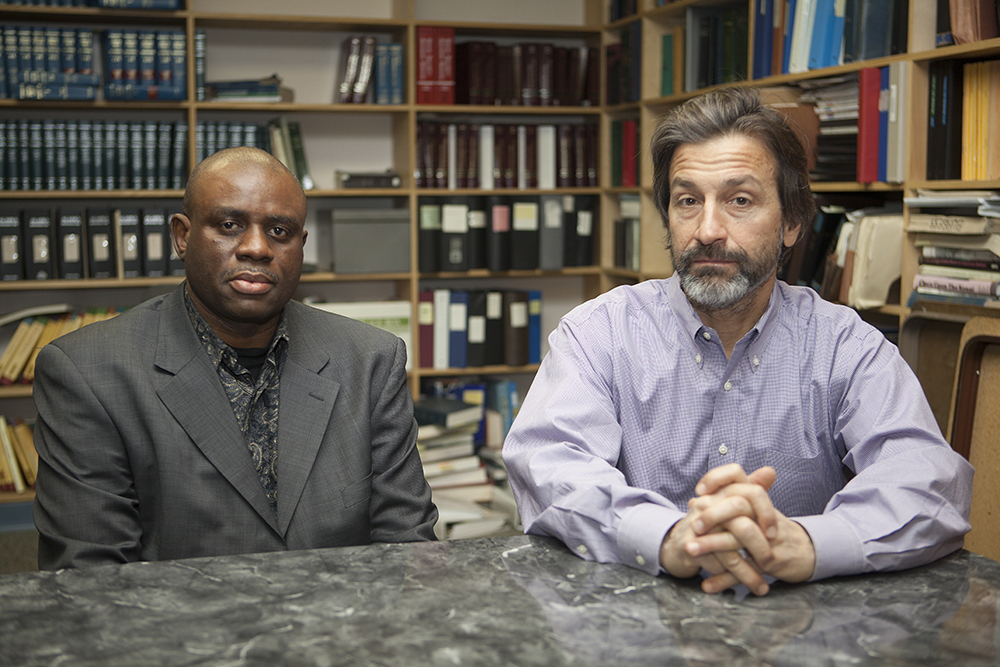Students accept NASA’s rocket challenge
by Jamie Gonzales |

Brandon Grimshaw (center) has assembled a crack team of engineers, like Nikolas Butler (left) and Jordan Shindle (right) to build a rocket to NASA specifications. Note: not all UAA Rocketry team members pictured. (Photo by Philip Hall/University of Alaska Anchorage)
The first few things Brandon Grimshaw launched as a kid definitely wouldn't have met NASA's rigorous standards for their annual Student Launch Initiative competition. But you can't say those early aerosol can "launches" at Boy Scout camp didn't spark excitement for a future career as an engineer. Now he's surrounded by a hive of finely tuned engineering minds-mechanical, electrical and computer science-who are helping to design and build a reusable rocket with an autonomous robot arm used to grab a payload. Sounds cool, right? It is. It's also a lot of work.
The skinny on the rocket
"We've come up with a 6-foot rocket, four inches in diameter, that's going to get to 3,000 feet," said Grimshaw. "If you go past [3,000], you're in trouble, if you go under it, you're in trouble. You want to hit 3,000 right on and that's not easy to do."
To get their mini-MAV rocket just right, the team has put in more than 100 hours coming up with the design, running simulations, building and testing sub-scale models and aggregating data to share with NASA reviewers each step of the way.
"MAV stands for Mars Autonomous Vehicle, so basically a Martian soil sample will be lifted with a robot, somehow, into the rocket," Grimshaw explained. With its payload in place, the rocket gets righted and launched to 3,000 feet. "The point when it stops-that's apogee, it's highest point-it will deploy what we call a drogue, in our case a drogue parachute. From 3,000 feet to 1,000 feet it will descend with the drogue. Then somehow, under NASA's requirements, the payload needs to eject with a parachute away from the rocket." If all goes to plan, rocket sections and payload float gently back to Earth and could, technically, be reassembled for another go.
"Rocket guys don't like what they call confetti-where you just shoot it up and it blows up and goes everywhere," he said. "They want you to be able to pick 'em up, clean 'em up and put them back on the launch pad. Saves a lot of money that way."
The multi-disciplinary team

Left to right: UAA Rocketry team members Stephen Arwine and John Berg, with NAR mentor David Erickson, working on sub-scale rocket build. (Photo courtesy of UAA Rocketry)
Grimshaw's background is sales, so he has no trouble talking to people. About a year ago, he started identifying and chatting up the folks who would become the UAA Rocketry team. As a transfer student from Utah State University, he'd seen past NASA Student Launch Initiative projects and, inspired by the success of the UAA College of Engineering's Baja Car team, he wanted more students to get hands-on, real-world engineering experience before graduation.
The NASA Student Launch Initiative project is an August-to-April commitment for team members. Since most engineering capstone courses, like the senior design project, are just three credits, the team has been working with the College of Engineering to figure out creative ways to get credit for all nine months of their work.
Grimshaw's brought on board mechanical engineers, electrical engineers, computer science engineers and one non-engineer-a project manager from the Master of Science in Project Management program to keep them on track. The full team, in addition to Grimshaw, includes: Stephen Arwine, Jordan Shindle, John Berg, Jacob Dempsey, Bryce Mahn, Bryan Beechinor, Andrea Hulman and Carolyn Forner.

John Berg (left) and Brandon Grimshaw assembling the sub-scale rocket. (Photo courtesy of UAA Rocketry)
Shindle, a senior, serves as the team's safety officer, ensuring the team maintains a safe culture and adheres to regulations both in the workshop and during test launches. Both Shindle and Grimshaw agree that the pace of the project, coupled with full class loads and family life, has kept them on their toes.
"We all have kids," said Grimshaw. "This project gives us really good knowledge, for our families and for us, on time management. Can we still do these projects and maintain family life? It gives us a good idea of what's involved if we really join the aerospace industry."
Shindle added, "NASA is really careful how they tailor the competition to make it as much as possible like a real-life design/build process."
The team has also connected with a local rocketry expert, David Erickson, founder of the Anchorage chapter of the National Association of Rocketry. Erickson serves as mentor and inspiration.
Countdown to Alabama
The team still needs to navigate two more hurdles-official NASA reviews of their progress-before being cleared for launch in Huntsville, Alabama, April 7-12.
Along the way, they've been responsible for raising their own funds. Grimshaw, designated team leader and chief talker, has been pleased with the community's response to his requests for support.

Just needs a little spit and polish. John Berg examines the totally reusable post-launch sub-scale rocket that seems to have picked up a little vegetation. (Photo courtesy of UAA Rocketry)
NASA limits all mini-MAV teams to $5,000 for the actual rocket costs. So far, the Alaska Space Grant Program has been their flagship sponsor for rocket parts. They've also had support from AMC Engineers, Spenard Builders Supply, SolidWorks, ReidMiddleton, Lowe's and the local IBEW chapter. They're currently working with UAA and Alaska Airlines to negotiate assistance with travel costs.
NASA also requires each team to spread the excitement around the community, paying particular attention to middle schoolers.
"It's a great opportunity to get STEM out in the public," said Grimshaw. "I didn't want to be a mechanical engineer because of all the math involved. Now I'm getting a minor in math, and love it."
That's the trick of science and engineering-behind every cool rocket launch is a whole lot of math.
"It starts clicking after you get through your algebras," Grimshaw explained. "I struggled forever, having to retake class after class. Then I got through all three of my calculus classes no problem, As and Bs." So, take heart, kids, understand algebra and calculus will be a breeze. Ace calculus and you just might be tapped to blow things up (in a safe, controlled way) as a career.
To see some math in action, stay tuned to the UAA Rocketry Facebook page, where they'll announce future test launch plans.
Written by Jamie Gonzales, UAA Office of University Advancement
 "Students accept NASA’s rocket challenge" is licensed under a Creative Commons Attribution-NonCommercial 4.0 International License.
"Students accept NASA’s rocket challenge" is licensed under a Creative Commons Attribution-NonCommercial 4.0 International License.
















